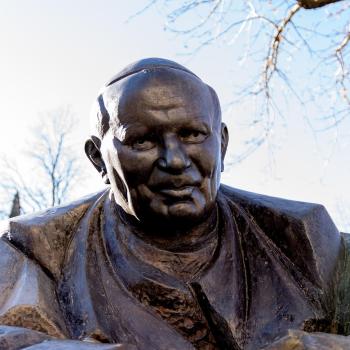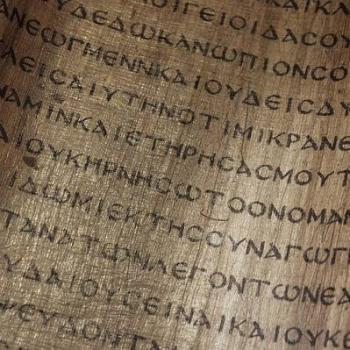THE QUESTION:
Many archaeologists have raised skeptical questions about the Bible’s historical accounts, especially in the Old Testament. How do conservatives respond?
THE RELIGION GUY’S ANSWER:
A September headline in London’s tabloid Daily Express proclaimed a “Bible Bombshell,” with “stunning new evidence that could prove” Joshua’s invasion of the Holy Land following the Exodus from Egypt. However, in the article the archaeologists involved, David Ben-Shlomo of Israel’s Ariel University and Ralph Hawkins of Averett University in Virginia, gave only carefully framed suggestions.
Their site has a stone enclosure for herded animals, and pottery indicating people lived outside the stone compound, presumably nomads living in long-vanished tents. The settlement dates from the early Iron Age, but testing of electrons in soil samples is needed to pinpoint whether it fits the Exodus chronology. And that wouldn’t prove these nomads were Israelites. (See below on Jericho.)
People thrill when a discovery is proclaimed as proof of the Bible, but it takes years if not decades to establish such claims. There can also be sensationalism when skeptics known as “minimalists,” Israelis among them, announce findings said to undermine the Bible. As a journalist, The Guy recommends caution toward assertions from all sides.
The pertinent archaeological maxim is “absence of evidence is not evidence of absence.” That is, a biblical event is not contradicted if archaeologists have not (or not yet) found corroboration from physical remains, non-biblical manuscripts, or inscriptions. There’s vast unexplored terrain in Israel, where only 50 of an estimated 6,000 sites have undergone thorough examination, with limited work at another 300. Surviving evidence from ancient times is necessarily spotty and interpretations can be subjective. Scholars usually end up with circumstantial plausibility, not absolute proof or disproof.
Conservatives energetically answer the minimalists. Their magnum opus is “On the Reliability of the Old Testament” (Eerdmans) by Egyptologist K.A. Kitchen of the University of Liverpool. William Hallo of Yale University said that “after decades of ‘minimalism,’ it is refreshing to have this first systematic refutation” from “a leading authority” on the relevant history. There’s also Associates for Biblical Research (ABR), devoted to the Bible’s “inerrancy” on history, which discusses ongoing issues at www.biblearchaeology.org.
Now the Bible defenders also offer the 2,023-page “Archaeology Study Bible” (Crossway). The 15 contributors uphold the Bible’s “historicity and truthfulness” and mostly teach at conservative Protestant seminaries and colleges. They have solid academic credentials, knowledge of the scholarly literature, and archaeological field experience in Israel. The Old Testament editor is John Currid (Ph.D., University of Chicago) of Reformed Theological Seminary, and the New Testament editor is David Chapman (Ph.D., University of Cambridge) of Covenant Theological Seminary.
For an example, let’s sketch the classic dispute over Jericho.
Past field work there was thought to corroborate Scripture. But in the 1950s, Britain’s Kathleen Kenyon said although remains of collapsed walls, fires, and grain storage parallel the Bible, this evidence comes from the wrong century. Her official report decades later was critiqued in 1990 by ABR stalwart Bryant G. Wood (Ph.D., University of Toronto). British museum executive Piotr Bienkowski then critiqued Wood, and Wood critiqued Bienkowski.
That back-and-forth is too complex to summarize here. The new commentary acknowledges the dispute and says firm conclusions remain “very elusive” due to Jericho’s many destructions and rebuildings across centuries, and early excavations that didn’t carefully preserve sites.
The defeat of Ai comes next in the Bible. The commentary freely admits archaeologists have unearthed no evidence for that battle, but says some experts think excavations occurred at the wrong place, and note this was only a small settlement (the Hebreew word for “city” also means “hamlet”).
Meanwhile, the commentary substantiates the Bible’s broad scenario with archaeological evidence showing a “marked change” in the early Iron Age. While Canaanites held coastal areas, as the Bible says, “hundreds” of new towns appeared “suddenly and without previous settlement” in interior hill country, which would track with Israelites moving in. The Jewish identification of the new settlers is provided by lack of pagan shrines and pig bones.
Another much-debated topic is whether accounts of the much earlier “patriarchs” could be true. As with Kitchen, the commentary contends that Biblical depictions of Abraham and his successors “correspond perfectly” with what we know about Middle Bronze Age culture from excavations at Ninevah and thousands of texts discovered at Ebla, Mari, and Nuzi.
There’s far less fussing over the New Testament, and the commentary cites numerous details that match non-biblical evidence. One big problem is Luke’s report that Jesus was born when Rome registered “all the world” for taxation in “the first enrollment, when Quirinius was governor of Syria.”
Quirinius became governor in A.D. 6, years after Jesus’ Nativity, and did visit Judea for tax purposes (which Acts 5:37 mentions). The commentary candidly admits that apart from Luke there’s no surviving evidence of any empire-wide census or an enrollment when Jesus was born. The commentary says Luke can also be translated “the census before Quirinius was governor” under another ruler, perhaps Saturninus. Or did Quirinius serve two separate terms but non-biblical texts cite only one? Or was he administrator in Syria before appointment as governor?
One of the commentary’s many apt features is editor Currid’s list of the 10 “most significant discoveries,” namely:
The Dead Sea Scrolls (ample ancient texts of all Hebrew Bible books except Esther), Rosetta Stone (key to deciphering Egyptian inscriptions), Tel Dan (‘House of David” reference in 733 B.C.), Ketef Hinnom Scrolls (quote Numbers 6 in the 7th Century B.C.), Moabite Stone (9th Century mention of war with Israel), Lachish Letters (cite Babylon’s impending assault), Gilgamesh Epic (7th Century B.C. parallel to the biblical Flood), Hezekiah’s Tunnel (Jerusalem’s 8th Century B.C. water system), Givat Hamivtar (crucified body in Jerusalem from Jesus’ time), and the Ugaritic Texts (depict Canaan’s religion and culture in the 15th to 13th Centuries B.C.).
The Guy would add Egypt’s Merneptah Stele from 1220 B.C., with the oldest known mention of “Israel” as a people. The commentary notes that “a few scholars” disagree.
History buffs, and not just Bible buffs, will be intrigued by the commentary’s thousands of explanatory footnotes and hundreds of sidebar articles alongside the scriptural text.
Those interested in these debates might subscribe to Biblical Archaeology Review (www.biblicalarchaeology.org), which published the Wood and Bienkowski articles and a recent excavation report from Ben-Shlomo and Hawkins. This agency also produces engaging archaeology books and videos.












